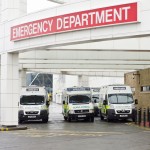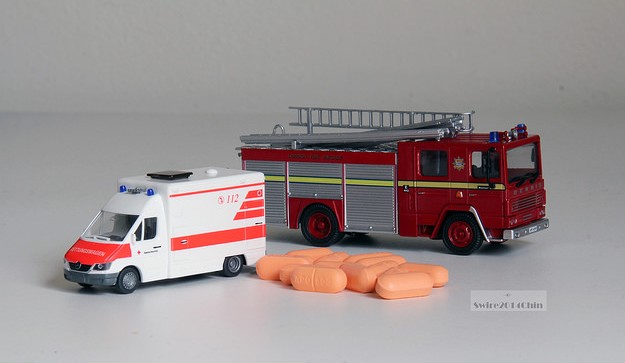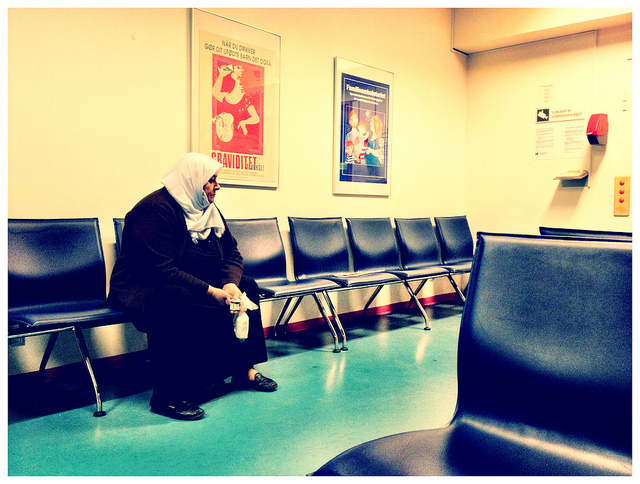
A sizeable proportion of the population take psychiatric medication, including antidepressants, anxiolytics or mood stabilisers. While important in the battle against mental illnesses, they may be associated with serious adverse reactions (in addition to more “benign” effects) that potentially require emergency hospitalisation.
Up to now, a consistent and representative overview of emergency admissions for adverse events after psychiatric medication has been lacking. Hampton and colleagues (2014) have just filled this gap by publishing a study in JAMA Psychiatry, which looks at the adverse effects of psychiatric drugs and emergency department visits.
Methods
The authors analysed emergency department records from 1 January 2009 to 31 December 2011 that were obtained from various national healthcare surveys and databases. Medical records from probability samples of adults (>19 years) with emergency department and outpatients visits were screened for adverse events related to antidepressants, antipsychotics, lithium salts, sedatives and anxiolytics, as well as stimulants.
Results
- From 2009 to 2011, an estimated 89,094 emergency hospital visits (95% CI 68,641 to 109,548) from therapeutic usage of psychiatric medication were recorded per year, which amounted to 9.6% (95% CI 8.3 to 11.0%) of all adult adverse drug event emergency hospital visits
- In every fifth case, patient hospitalisation was necessary, which is similar to hospitalisation rates for non-psychiatric emergency hospital visits (25.3%, 95% CI 20.6 to 29.9%)
- Women were more often affected than men
- Adult women: 46.4 visits, 95% CI 36.0 to 56.8, per 100,000
- Adult men: 30.3 visits, 95% CI 23.0 to 37.6 per 100,000 men
- Overall admissions were similar across age groups

Nearly 1 in 10 of all adverse drug event visits to emergency departments are due to psychiatric drugs, including antidepressants, antipsychotics, lithium salts, sedatives, anxiolytics and stimulants. Image licensed via CC BY-NC 2.0 to Swire
The total number of annual emergency department visits for psychiatric medication adverse drug events were:
- Sedatives and anxiolytics: 30,707 (95% CI, 23,406 to 38,008)
- Antidepressants: 25,377 (95% CI, 19,051 to 31,704)
- Antipsychotics: 21,578 (95% CI, 16,599 to 26,557)
- Lithium salts: 3,620 (95% CI, 2,311 to 4,928)
- Stimulants: 2,779 (95% CI, 1,764 to 3,794)
The estimated annual emergency department visits per 10,000 outpatient prescription visits were:
- Lithium salts: 16.4 (95% CI, 13.0 to 19.9)
- Antipsychotics: 11.7 (95% CI, 10.1 to 13.2)
- Typical antipsychotics: 26.1 (95% CI, 21.6 to 30.5)
- Atypical antipsychotics: 9.1 (95% CI, 7.8 to 10.4)
- Sedatives and anxiolytics: 3.6 (95% CI, 3.2 to 4.1)
- Stimulants: 2.9 (95% CI, 2.3 to 3.5)
- Antidepressants: 2.4 (95% CI, 2.1 to 2.7)
Other notable results included:
- Typical antipsychotics were implicated in emergency department visits at a 2.9-fold higher rate than atypical antipsychotics. However, excluding haloperidol from this analysis resulted in much less difference between the two classes of drugs, which suggests a particularly poor tolerability of haloperidol
- There was no difference between long- (e.g. diazepam) and short-acting benzodiazepines (e.g. midazolam) regarding both emergency department visits as well as subsequent hospitalisation
- In the youngest age group (19-44 years), emergency department visits were most often associated with antipsychotics (31.3%) and antidepressants (30.5%). In older patients, this shifted to sedatives and anxiolytics (>64 years, 55.2%)
- Antidepressants were the main contributor to emergency department visits by female patients in the youngest age group (36.2%, 95% CI 32.5 to 40.0%), while antipsychotics were the leading cause in men of comparable age (40.1, 95% CI 34.4 to 45.9%)
The authors also offer a very handy overview of individual medication, which for brevity’s sake will be restricted to the five worst “offenders” in terms of proportion of emergency department visits for adverse drug events:
- Zolpidem Tartrate: 11.5% (9.5 to 13.4%)
- Quetiapine Fumarate: 7.7% (6.5 to 9.0%)
- Alprazolam: 6.3% (5.0 to 7.6%)
- Lorazepam: 6.2% (4.8 to 6.7%)
- Haloperidol: 5.5% (4.3 to 6.7%)

The insomnia drug Zolpidem Tartrate and the antipsychotic Quetiapine Fumarate topped the list of psychiatric drugs resulting in emergency department visits. Image licensed via CC BY-NC-SA 2.0 to Peter Kirkeskov Rasmussen
Conclusion
The authors conclude:
Psychiatric medications are implicated in many adverse drug events treated in US emergency departments. Efforts to reduce adverse drug events should include adults of all ages but might prioritize medications causing high numbers and rates of emergency department visits.
Limitations
- Data rely on documented cases of adverse drug events by patients who sought help. This may bias the sample towards acute (and well-known) adverse effects, while chronic adverse drug events such as metabolic problems after long-term antipsychotic treatment may go unnoticed
- For the same reason, occurrences of self-harm were not taken into consideration
- Off- or on-label use of medication (especially in terms of sedatives or anticonvulsants) could not be considered, and it’s a pity that no information on comorbidities or drug dosage was available. This is unfortunate because non-adherence to treatment could have overestimated the figures presented here, which may be an issue, particularly for psychiatric medication
- On the other hand, there are potential reasons for underestimation, for instance by excluding patients whose medication was initiated upon hospital discharge
Summary
Overall, psychiatric medications accounted for a significant share of emergency department visits. The fact that some drugs stand out should give reason for concern and raise further awareness about potential health risks. In addition, it should be kept in mind that while adverse drug events that require hospitalisation are fortunately only the most severe cases, other (perhaps less severe) side effects are significantly more frequent and likewise deserve consideration.
Link
Hampton LM, Daubresse M, Chang HY, Alexander GC, Budnitz DS. Emergency Department Visits by Adults for Psychiatric Medication Adverse Events. JAMA Psychiatry. 2014;71(9):-. doi:10.1001/jamapsychiatry.2014.436. [PubMed abstract]
Featured image: Brendan Howard / Shutterstock.com


RT @Mental_Elf: Psychiatric drugs are associated with emergency department visits http://t.co/GRTB6QBsur
RT @paulamreid: Interesting study from US about link between side effects of mental health medication + A+E visits (via @Mental_Elf) http:/…
“Psychiatric medications are implicated in many adverse drug events treated in US emergency departments” http://t.co/99iyg5NcGf
Today we summarise a @JAMAPsych study on the adverse effects of psychiatric drugs & emergency department visits http://t.co/FNEkupVmMs
The adverse effects of psychiatric drugs and emergency department visits via @Mental_Elf http://t.co/oJ5YROVje5
Psychiatric drugs and emergency department visits http://t.co/gk3uev7k8W
Nearly 1 in 10 of all adverse drug event visits to emergency departments are due to psychiatric drugs http://t.co/FNEkupVmMs
@Mental_Elf What proportion of drugs taken are psychiatric drugs? The 1 in 10 stat isn’t very helpful without knowing this.
@Mental_Elf important issue, not sure why it is under assessed – also #interactions with #illicit #drugs – http://t.co/DtBAp3qhBf
The Mental Elf liked this on Facebook.
Lisa Eden liked this on Facebook.
Becky Fredericksen liked this on Facebook.
Carina Kirby liked this on Facebook.
Mental Elf: The adverse effects of psychiatric drugs and emergency department visits http://t.co/oesUafekxu
New study finds psychiatric medications are implicated in many adverse drug events treated in US emergency depts http://t.co/FNEkupVmMs
Zolpidem Tartrate & Quetiapine Fumarate topped the list of psychiatric drugs resulting in emergency dept visits http://t.co/GRTB6QBsur
@Mental_Elf oh blimey. On some big offenders :(
.@Mental_Elf Approximately the same as the rate of serious drug-related SFX in hospitalised US patients: http://t.co/yKbHEZTYts.
http://t.co/izb1KkVrq5 or are people with mental health diagnoses more likely to abuse medication & psychotropic medication is available?
30,000 ER visits/yr for complications of psych medications (not even counting pain meds) http://t.co/0sOB2oDe1I
@Mental_Elf
@AllenFrancesMD @Mental_Elf Not possible to accurately ascertain all ER visits for ADEs (psych meds or other). This is an underestimate.
Don’t miss: Psychiatric drugs are associated with emergency department visits http://t.co/FNEkupVmMs
@Mental_Elf Not surprising given their strength and capacity to do so much to our systems
@Mental_Elf What we need is something mild available in pharmacies.
The adverse effects of psychiatric drugs and emergency department visits http://t.co/N5yLJpuK74 via @sharethis
“@JohnEJefferson The adverse effects of psychiatric drugs & emergency department visits http://t.co/whY6gCYjx4 via @sharethis” #mentalhealth
The adverse effects of psychiatric drugs and emergency department visits http://t.co/h7RsI9GEdx
The Mental Elf liked this on Facebook.
Lisa Eden liked this on Facebook.
Becky Fredericksen liked this on Facebook.
Carina Kirby liked this on Facebook.
[…] the person might’ve been far better off with simple talk-therapy than with drugs. According to the National Elf Service, “From 2009 to 2011, an estimated 89,094 emergency hospital visits from therapeutic usage of […]